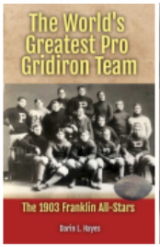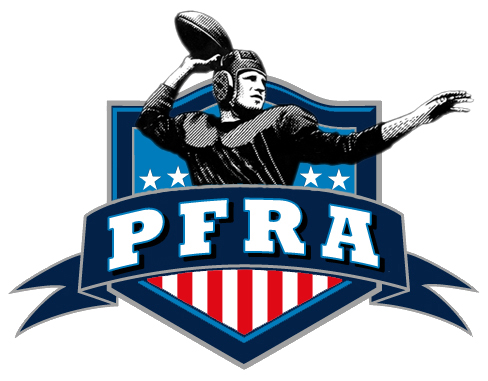It may be surprising to feature Cal Tech two days in a row, but they deserve the recognition for exploring player equipment possibilities unlike anyone else. The eyeglass shields discussed in yesterday’s story offered a vision of football’s future, even if no one else paid attention. — www.footballarchaeology.com
Timothy Brown of
Football Archaeology found some images of two-tone colored football jersey numbers and dug up some history on these unique features from the past.
Tim takes us back to Cal Tech and their innovation of split and two-tone colored jersey numbers with his original Tidbit titled:
Two-Tone and Split Jersey Numbers.
-
Transcribed Two-Tone CalTech Jerseys with Timothy Brown
Hello, my football friends. This is Darin Hayes of PigskinDispatch.com. Welcome once again to The Pig Pen, your portal to positive football history. And welcome to Tuesday, FootballArcheology.com day. Timothy P. Brown, the founder and head writer of that site. Tim, welcome back to The Pig Pen.
Hey, Darin. Good to see you again on a beautiful summer evening. Looking forward to talking a little bit of old football. Yeah, we are getting to the point where football is.
You know, there's pads being clacked around the country and balls being thrown. And we're going to be seeing a lot of that real soon. Well, of course, we can still watch our friends north of the border who have been playing, but it is getting exciting.
Yeah. I mean, well, I was going to say before you added the CFL, our CFL friends, I've been I don't I haven't been really watching when it's on CFL Plus, but when it's on the CBS thing, you know, I take those and watch those games. So it's fun.
It was some great, great football. It definitely is a lot of offense. They really gear it towards scoring some points.
So that's what makes it attractive. Yeah, yeah, yeah. Yeah.
So we're going to talk tonight about one of your tidbits that you had back in June, you know, just a little over a month ago and talking about some jerseys, which is a favorite topic. I love talking about those and something in particular unique about the numbers, and I'll let you take it from there. Yeah.
So this is. Sometimes, I can't even recreate how I found some of these stories, but I think what happened was I I was looking, somehow I'd come across the story about Caltech. So California technology.
And right there, you know, it's going to be something wacky when that school name and football come together. There's something going to be. Yeah.
Well, they don't play football anymore, at least at the varsity level. But they did for a long time. You know, they had success in the California small college circuit, you know, the Occidentals and the Whittiers and, you know, those kinds of schools.
And. But, you know, they sit in the school in Pasadena. And so, you know, one of the cool things about them is that there's a picture of one of their home games in the Rose Bowl, in 1933 or something.
But, you know, they played their games in Tournament Park before the Rose Bowl stadium was built and then in the Rose Bowl because they're literally right next door. And so anyways, you know, they did attract a couple of thousand fans to see a game under the lights and in the Rose Bowl. So, you know, kind of fun stuff.
I'm sure it had to be a big treat for any of the opposing teams to get a chance to play there. But so somehow, I came across them. I actually wrote two stories in a row about Caltech because the previous tidbit was about the face shields that they wore in the 1940s and 41st centuries.
And but they ended up, you know, they were basically shields to allow guys who wore glasses to play football. And this is before face masks, you know, were common. And so somehow, in searching through their yearbooks, I came across a couple of pictures where it's like, what is going on with those jerseys? And so what they had was, you know, for want of a better term, two two-toned numerals on the jerseys.
So they they only had numbers on the backs. They didn't have them on the front. But that they had, you know, a wide, a dark, wide stripe that ran through the sleeves and then the body and maybe, you know, just above the belly button, but not all the way up at the chest.
And so it's probably a six-inch wide, seven-inch wide stripe. And because that thing was there when they put the numbers on, you know, they couldn't have like a dark number. Because it would have overlapped with the dark stripe.
And then, on the rest of the jersey, where it's white, they couldn't have a white number. So what they did was they had a two-tone number. So on the dark where, you know, where it went over the dark stripe, it was a white number.
But then, above the stripe, it was dark. Yeah. So let me let me cut in here real quick here, folks.
If you want to, Tim will explain this. You can see a great example of it. We have the link in the show notes to take you right to Tim's
football archaeology dot com site.
He's got some great images of what he's talking about there. So you can appreciate that. So I'm sorry.
Go ahead, Tim. Yeah. So, yeah, I should I should have mentioned that myself.
But so the thing is, you know, I mean, like, I literally track every college yearbook that I look at, you know, just to make sure I have covered this turf before or not. And, you know, I probably need to go through a bunch of them just because I'll see new things. But I've looked at, like, now, I'm just under thirty-four hundred old college yearbooks that I've paged through to look at the, you know, the football section.
And I've never come across these two-toned numbers before, or at least I haven't noticed them. Anyway, I think they're unique. You know, I've seen like Penn used to have, or Penn probably still does.
And Harvard, both schools, I've seen like the P or the H logo where. There'd be a diagonal, you know, split, you know, from lower to lower to upper. And so one would be maroon, and the other would be white, and one would be blue and the other white.
So, you know, so if you can imagine that, if you've seen that logo, then that's basically what it looked like, except as a horizontal split, you know, upper and lower of the dark and the white. But anyway, it's just one of those weird things that thankfully never caught on. And as much as, you know, nowadays it used to be, you could only have Arabic letters, and then there were certain constraints; you could only use these typefaces.
Nowadays, there's so much. You know, basically unreadable. And I think I think they still there's just a greater number of fonts.
I think they can use what they've got. So we're going to have, you know, a certain size block number to be legal. I think even NCAA, because otherwise somebody like Oregon would be pushing the limits probably beyond what Caltech did in this case.
Yeah. Yeah. I mean, you have to.
Yeah, it's just, you know, I've seen too many like white on gray uniforms, you know, white numbers on gray uniforms. The fonts are all the things that they look like. They're from NASCAR.
They're just big, ugly. And so anyway. And don't get me started on colored fields because that's another story.
Yeah. Yeah, I know there's one blue one in particular. I don't even know if I can watch the games.
It drives me crazy. But great football there, but not the great field. Yeah.
Yeah. Yeah. So, anyway, this is just one of those things that is kind of bizarre.
I mean, I've never seen it. You know, it obviously didn't take off, and it didn't become popular, but, you know, maybe somebody else had one. If they do, reach out and let us know. Well, that's why we count on you for the bizarre football items.
And you definitely deliver those. And this is one of them. So we love it.
I mean, I think it's a great it's great conversational pieces. And you learn a lot about what people were trying to experiment with and innovate or try to gain an advantage over the other team or whatever. Personal style choice.
I don't know what you'd call this, but it's cool stuff. It's really interesting. So we appreciate that.
I mean, I've used it a couple of times, but it's the, you know, innovation versus oddity. You know, it's if people adopt it and, you know, it takes off, then, oh, you were innovative. But if you did something that everybody thinks, especially looking back, you know, 50, 60 years later, you know, what in the heck were they thinking? But why do those people have stripes down the middle of their helmets? What are they crazy? Yeah, yeah, yeah, yeah.
Those things. Yeah. I know.
Wow. You know, if you could share with us, you know, the listeners so we can enjoy your tidbits because you have items like this, you know, seven days a week and you have you have some beauties that are come on there like this and you'll get a good chuckle out of her. Just be entertained for, you know, a few minutes and talk about the people at the work around a water cooler next day or whatever.
But he's well; you're having a few cold ones. It's a great way to do it and get some football history every single day. So, Tim, could you share how the folks could join you in that?
They appreciate that. Sure. You know, the best way to do it is just to go to
football archaeology dot com and subscribe.
You can do that for free. And then, you know, basically, you'll get an email from me every night at seven o'clock Eastern. I'm also on the substack platform on on Twitter and on threads.
So and all under the same name,
football archaeology. Well, Tim Brown, thank you very much once again for talking to us about some great football history and your
football archaeology dot com tidbits. And we will talk to you again next Tuesday.
Very good. Thank you very much. Have a good one.
Love the football jersey designs and evolution wait till you check out the
History of American Football Jersey.
-
Football Jersey Frequently Asked Questions
-What are American football jerseys made of? Modern jerseys are a mix of synthetic fibers such as polyester or a blend of different materials such asspandex, for more check out our in-depth study of
The Make up and Materials of Football Jerseys.
-What are some of the unique football jerseys in history? Gridiron jerseys with logos on the front were some what of fad once upon a time. Check this story titled
Football Jerseys with Emblems.
-Whose college football jersey was the first to be retired? Red Grange's Number 77 Ilinois Illini jersey was the first college uni to be shelved in 1925. There were a couple more about the same time and we chatted with a college football expert historian help divulge
College Football and its First Retired Jerseys.
-When did football jerseys start having numbers on them? Though there was documented talk of it since 1894, players did not all wear digits in a game until the 1905 Iowa State at Drake game, check this out more on this story
The Origins Of Football Player Numbers.
-Who are some of the most famous NFL players at each jersey number? From Red Grange's jersey number 77 to Tom Brady's iconic number 12, a slew of NFL players made their digits proud. Want to know more? You are in the right place as we covered all 100 jersey numbers and the best to wear each:
About Football By Numbers.










